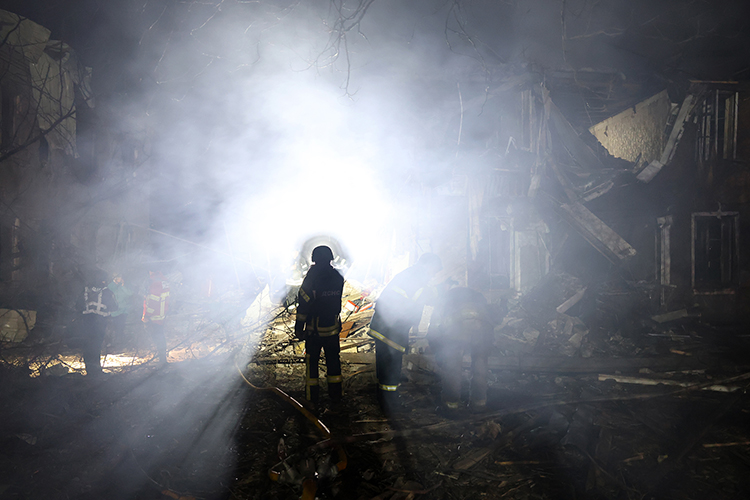Attention! The material contains sensitive information, and the photos are scenes of cruelty that can shock you.

Since February 24, 2022, a large-scale invasion of Russian troops began in several directions: in the area of the demarcation line in Donetsk and Luhansk regions, from the temporarily occupied Crimea and from the Belarusian side to Sumy, Chernihiv and Kiev. Russian troops planned to capture the capital in two to three days, but their plan failed. Kiev resisted, instead the Russians occupied part of the area and approached the capital close to the capital. There were fierce battles near Kiev.
Today, the Ukrainian Association of Professional Photographers publishes photos of Oleksandr Ratushnyak. The photographer talks about his work in the first month of the war, when chaos raged around, and Kiev defended itself with all its might.
With this material, we begin a series of publications about the fighting for Kiev at the beginning of the full-scale Russian invasion in the spring of 2022.
“Kiev in three days”
In the first days of a full-scale war, the Russian military advanced towards Kiev. We passed through Ivankov, Obukhovichi, Katyushanka and other settlements north of the capital. However, the key points were the towns of Borodyanka, Bucha and Irpin. The Russians shelled Borodyanka from the ground and air — it is one of the most destroyed settlements in Kyiv region. There was serious fighting in Vasilkov, Russian troops from the cities shelled Irpin, fighting continued near the airport “Antonov”.
At the end of February, Russian troops captured Vorzel and Nemishayevo. A column of Russian equipment entered Bucha on Vokzalnaya Street. The column was smashed by the Ukrainian military. After an unsuccessful attempt to enter Bucha, the Russians shelled the city. In March, Russian troops struck Irpen. On March 5, Bucha was completely occupied. Since mid-March, the Ukrainian side has agreed with the Russians to create “green” corridors to evacuate people. Before that, the residents of the occupied territories of the Kiev region were taken away by volunteers. People were taken near the almost destroyed Romanovsky bridge in Irpen. Many people walked, some drove cars. Many wrecked cars, even with the inscription “Children”, remained on the Zhytomyr highway — they were shot by Russian military.
On March 21, the Ukrainian military liberated the village of Makariv. At the end of the month, the Armed Forces surrounded Irpin, Gostomel and Bucha. Russian troops began to withdraw from the occupied territories of Kiev region. Irpin was liberated from the Russian occupiers on March 28, and Bucha on March 31.

Traveled by bike, scooter or subway to shoot
Photographer Oleksandr Ratushniakdecided to stay in Kiev until the last, considered the critical moment, except that the Russians blew up the Chernobyl nuclear power plant. The photographer explains that from the first day of the war, he held on to friends who had united in a volunteer unit.
“On February 24, I came to my friends who joined the unit, they were based in Kyiv. I decided that I would photograph their work, and there it would be visible. Since the guys were without heavy equipment, and for specific tasks they traveled in cars with a limited number of seats, so they did not need an extra person. Then I realized that it was necessary to look for some other ways of fixing the war,” says Ratushnyak.


Oleksandr Ratushnyak from his own transport had only a scooter and a bicycle, so it was with them that he reached different points of the city and region:
“Often on a bicycle or on the subway, to save fuel, I went to various “arrivals” in Kiev. I had to dress well and ride a scooter to Irpin, Bucha or Stoyanka. Then there were evacuations. Everyone leaves from there, but only I am alone in that direction,” recalls the photographer.




Alexander received accreditation from the Ministry of Defense only on March 11, before that he worked at his own risk. Once near the supermarket, I almost got “for nuts”, because he was filming the queue of people to the store.
“The video from the phone was removed. Good thing they didn't beat. To be honest, and after that, accreditation did not help much, because at the checkpoints they did not hear about such a document. Everyone focused on the passport and registration,” says the photographer.

Oleksandr Ratushnyak explains that most of the stories he managed to shoot thanks to his acquaintances with people. For example, volunteers who carried aid or evacuated civilians.





“Towards the end of March, I got acquainted with the Carpathian Sich battalion, so I managed to capture the combat actions directly. But just as before, I was taken on the task, since they did not need an additional burden. After all, going in the middle of the night with only a camera in hand is not a very good idea,” recalls Alexander.




Oleksandr Ratushniak — Ukrainian photojournalist. Knight of the Order “For Merit” III degree (2022). He worked in a bank and took pictures in a studio. He has worked with news agencies, including AFP and Reuters, and is now a freelance photographer. Photographed the events that took place on Euromaidan. Actively documents the Russian-Ukrainian war.
Photographer's social networks:
Facebook
Instagram
Recall that the Ukrainian Association of Professional Photographers has started a series of materials dedicated to key events of the Russian war against Ukraine, where he publishes memoirs and photographs of Ukrainian documentary photographers.
The project is implemented thanks to support of ZMIN.
The material was worked on:
Researcher of the topic, author of the text: Katya Moskalyuk
Bildeditor: Vyacheslav Ratynskyi
Literary Editor: Julia Foutei
Site Manager: Vladislav Kuhar



%20(750%20x%20360%20%D0%BF%D1%96%D0%BA%D1%81.)%20(2).png)


















